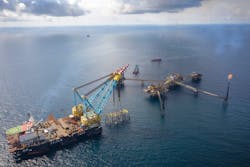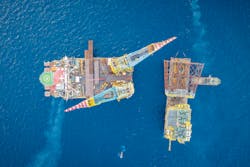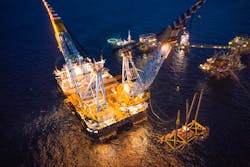Saipem 7000 performs record platform lift at KMZ complex offshore Mexico
Piling methods adapted for soil conditions, Pemex specs
Pemex is adding a new gas compression platform to the Ku-Maloob-Zaab (KMZ) oil and gas production complex in the Bay of Campeche offshore Mexico. Previously, all associated gas from the heavy-oil KMZ fields, 105 km (65 mi) northeast of Ciudad del Carmen, has been reinjected to enhance oil recovery. With the new dedicated compression platform CA-KU-A1 the company is targeting a steep increase in gas production.
Last October the crane vessel Saipem 7000 installed the platform and bridge connections to the existing KMZ field center. The 11,100-t gas compression module, according to Saipem, was the heaviest single topsides lift to date in the Gulf of Mexico. The same vessel had established the previous record 12 years earlier by installing the 10,473-t integrated deck for the PB-KU-A2 production platform. Both platforms were built by Dragados Offshore in Mexico, with CA-KU-A1 the first completed project at the company’s new yard in Altamira. Dragados also designed the Integral Gas Compression System which will be capable of compressing 450 MMcf/d for Pemex at the KU-A1 process center. As with the PB-KU-A2 platform deck, which Dragados constructed at its Pueblo Viejo yard in Tampico, Saipem performed all related transportation and installations for the compression system project.
Saipem is in the process of establishing a new company in Mexico dedicated to offshore projects, led by Country Manager Raul Gonzalez. “Pemex’s current administration has started moving away from big fabrication/installation contracts and is now favoring service contracts,” Gonzalez explained. “They prefer to issue contracts to companies that will also finance the project. In this case, Dragados will develop and start production, with Pemex paying a rental for the transfer of the gas. It has been a challenge for DOMSA [Dragados] to act as operator and to make all decisions regarding the design and installation as they do not have the benefit of passing on any extra costs that may arise to Pemex. Under the terms of the service contract, they have to assume full responsibility if they get something wrong.
“This arrangement is also a first for Saipem. We are used to working with offshore operators as a contractor, with separate contracts issued for the fabrication and the T&I. But having said that, there has always been a need for strong interfaces with the fabricator to ensure that their structure fits our vessel, and we are also used to collaborative engineering in the design of the proposed platform lifting points.”
For this latest project Saipem’s scope covered the CA-KU-A1 platform, two tripods and two bridges, one housing the flare with the other carrying pipelines to the KU-A1 platform. The company assigned five barges for the campaign, with the S45 used to transport the jacket and the deck. Pickup of the various structures from the single quayside at Altamira had to be performed in a short period of time to coincide with the arrival of the Saipem 7000: after completing a module installation for Wintershall Dea’s Dvalin project in the Norwegian Sea in early August, the crane vessel mobilized directly for the Gulf of Mexico.
According to Gonzalez, “the journey turned out to be quite an adventure: the vessel was supposed to bunker in the Bahamas then sail to Mexico for customs clearance. But Hurricane Dorian hit a few days before the scheduled arrival, forcing it to re-route to the Cayman Islands and Jamaica for bunkering. It eventually arrived in Mexican waters and following customs clearance to suit the requirements of Pemex and the Mexican authorities, started the offshore campaign on Sept. 25, finishing on Oct. 24.
“Saipem operates a year-round, global weather forecast service: we always know how bad conditions might be in any part of the world when we sign a contract, and our planning takes this into account. Having said that, the Saipem 7000 is a big vessel and can therefore sustain worse weather conditions than smaller construction vessels. For this project, there was only one bad day in terms of weather downtime during the offshore campaign and even that was not particularly bad.”
Lifting, piling adjustments
The new compression module, which replaces existing modules on KU-A1, has been designed as a topsides. “What Dragados needed to take into account in the layout,” Gonzalez explained, “was to ensure that the center of gravity of the topside suited the lift, which at 11,500 t was very close to the capacity of the Saipem 7000 based on the reach of its cranes. Although the cranes are designed for a maximum load of up to 14,000 t in tandem, you lose capacity as you outreach.
“Because of the size of the compression module, Saipem and Dragados needed to work together to ensure that the center of gravity remained within a certain envelope. Before the load-out of the module, Dragados presented to us the actual center of gravity so we could ensure that the structure could be lifted. As the center of gravity also moves in a vertical position, Dragados designed two lifting frames with different sizes to suit the variations. Once the Saipem 7000 had set the deck down, we cut the frames out.”
Placement of the 3,500-t jacket also had to be within very strict tolerances imposed by Pemex. “In this instance, we did do a couple of things differently from our other projects in the Gulf of Mexico. Jackets in the Mexican sector are normally piled through their legs, with the pile installed in three sections (all welded on top of each other) due to the height of the jacket. For this project, we used two sections of piles to allow both Dragados and Saipem to cut costs and operations offshore: the challenge was that the piles were very long, the lead section was 130 m (426 ft) and the add-on another 80 m (262 ft), while the normal arrangement would be three sections of 60-70 m (197-229 ft). For most contractors this late change in design to cut operations and costs would normally not be possible, however having a vessel like the Saipem 7000, allowed Saipem to use the competitive advantage provided by the crane’s height and capacity to upend these sections.”
Another issue that had to be addressed was the piling method for the tripods. “There was a risk that the original pile design and make up would not be installable due to the soil conditions in the area,” Gonzalez explained. “Normally you pick up the pile with an internal lifting tool, position it through the leg, then disengage the lifting tool and deploy a hammer to drive the pile down. In this case, however, the piles were to be driven on skirt sleeves outside the legs which reduced the support to the piles. That, coupled with variable soil conditions - mostly very soft, but with two hard layers at depths of 9 and 15 m (29.5 and 49.2 ft) - forced us to use a vibro-lifting tool, which acts both as a hammer and a holding tool. Without it there was a risk that a pile could stop at 9 m (29.5 ft) penetration and buckle. It also meant creating three different pile designs for each scenario, each significantly reinforced.
“While there was only a very small possibility that any given pile would only self-penetrate to 9 m and get damaged, it was fortunate that this risk was mitigated during the engineering phase, even if it meant extra expenditure as during the installation one pile did indeed stop at 8.5 m (28 ft), while all others penetrated up to 17 m (56 ft). If we did not have that additional tool onboard, we would not have been able to safely install the platform because of that one pile.”
Future needs
Following the opening up of Mexico’s E&P sector by the country’s previous administration, various international companies are considering shallow-deepwater field developments. Pemex itself plans to install over 100 new platforms, according to Gonzalez. “Pemex has two main priorities: they want to reactivate all projects in their backlog that have been suspended and they are mainly targeting shallow-water projects. There are a couple that would involve heavy lifts.”
The S7000 could also play a part in future decommissioning programs. “We do know there is a need for this: there are a lot of structures offshore Mexico that need to be removed, and for the bigger platforms, or removing the bigger chunks, the Saipem 7000 would make sense. However, Pemex is not at that point yet because there is no incentive for them to do so at present, aside from complying with legal requirements.” •
About the Author
Jeremy Beckman
Editor, Europe
Jeremy Beckman has been Editor Europe, Offshore since 1992. Prior to joining Offshore he was a freelance journalist for eight years, working for a variety of electronics, computing and scientific journals in the UK. He regularly writes news columns on trends and events both in the NW Europe offshore region and globally. He also writes features on developments and technology in exploration and production.




